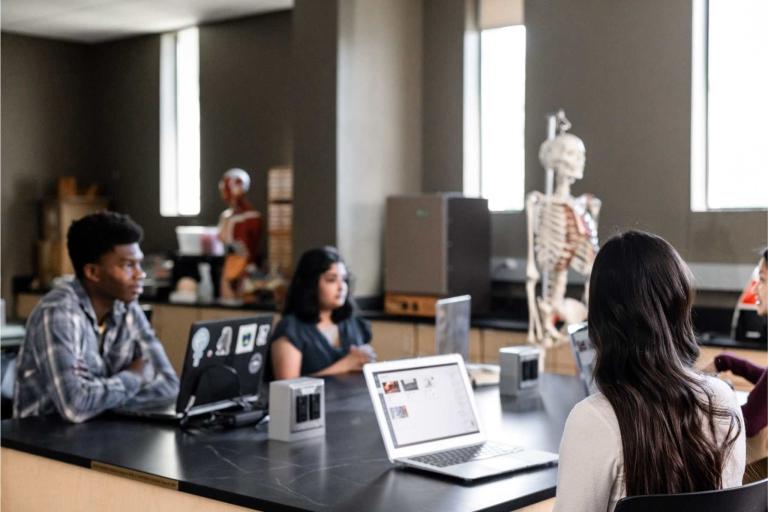
Educators love it when their classrooms are in total attendance or every student submits an assignment on time. However, they also know that learning is more than just showing up and completing assignments. The learning process is more complex, requiring active student engagement and participation.
Student engagement continues to be an academic concern as educators notice a shift in student attention spans and learning preferences. This shift motivates schools and institutions to prioritize holistic approaches that further involve students in their learning journey – putting an end to passive learning cycles.
To get students involved, we must first have a clear understanding of student engagement. In this article, we’ll dig deeper into the different types of student engagement and the best practices for each.
What is Student Engagement?
Student engagement indicates the level of active involvement students demonstrate in the classroom and in their broader learning journey. This level can range from passive, non-engaged learners to active, engaged learners. A student’s participation is further measured by their level of understanding, connection to the learning material, and enthusiasm for the instructional environment.
Overall, student engagement impacts what skills are acquired and what knowledge is gained. To offer students memorable, meaningful, and engaging learning experiences, we must first understand the types of engagement. Let’s take a look.
6 Types of Student Engagement
Determining whether students are engaged can prove to be challenging. For instance, a student may be physically engaged in a class activity but lack understanding and intellectual engagement. In an effort to get students fully engaged, here's a look at all engagement types and strategies to foster each.
1. Intellectual engagement: When introduced to learning material, are the students expressing curiosity? Do they have a genuine interest in the subject matter at hand? If so, these are key signs of students having intellectual engagement. With intellectual engagement, students seek to understand the subject matter and build their knowledge base. Educators can foster intellectual engagement with exciting research projects and presentations. Another way to get students invested is through real-world applications. With the help of edtech tools and resources, educators offer digital simulations to enhance understanding in certain subjects. Encouraging questions and deeper conversations also cultivate interest in learning materials.
2. Emotional engagement: Emotional engagement is determined by the student’s emotional connection to the academic environment and their learning experiences. Consider whether students feel supported in their learning journey. Do they have a positive connection to the learning environment? Do they feel like they can grow and develop their skills? Improve student's feelings towards their learning by building a safe and supportive educational environment. Offering encouragement, constructive feedback, and personalized learning helps students develop positive emotional engagement.
3. Behavioral engagement: Behavioral engagement focuses on how students respond, act, and behave in their learning environments. Is the student paying attention, or are they distracted? Are students completing their assignments, or are they not submitting them? Educators can facilitate healthy academic behaviors by maintaining an organized learning structure and establishing clear expectations. To further address behavior, educators can reinforce positive academic behaviors and offer constructive feedback when needed.
4. Physical engagement: Enhance the learning experience by adding physical activity and/or props to instruction. This connects the mind and body, making the instructional activity more memorable. When planning, ask the following: Is there an opportunity to get students out of their seats? How can we get students actively involved? What physical props and examples can be used? By incorporating role-playing, interactive simulations, and hands-on activities, educators can bring excitement to the learning process.
5. Social engagement: How can students interact with one another? What assignments or projects support teamwork? Cultivate collaboration and communication among students and their peers. Socially engaged students interact with peers, sharing knowledge and perspectives about learning material. This level of interaction builds relationships and interpersonal skills. To further establish a collaborative and supportive environment, educators can assign group projects and hold class discussions.
6. Cultural engagement: Cultural engagement can refer to how students interact within their academic ecosystem and whether they feel included in their learning environments. Diverse learning settings, inclusive academic materials, and activities bridge cultural gaps – bringing all learners together. Educators can learn about their student's backgrounds, incorporating that knowledge into conversations and learning materials. This allows every student to feel valued and represented.
Research on Student Engagement
By understanding the specific types of engagement, educators can better focus their instruction to meet the needs of their students and engage them on every level. However, there are other factors to consider when measuring student engagement. For instance, studies show socioeconomic factors such as access to technology (82%), psychological well-being (82%), home/life wellness (81%), household income (80%), and learning disabilities (80%) have a substantial impact on student engagement.
These factors are highly considered as schools and institutions seek opportunities to increase student involvement. Also, with student engagement directly correlating to student well-being and academic success, educators must invest in maintaining engaging learning environments. Let's take a look at the role educators play in student engagement.
Role of Educators in Student Engagement
Educators hold a pivotal role in shaping student engagement. Classroom management, preparation, and strategy can all affect the student’s experience. Learning materials and their use can impact the student’s level of engagement. By providing immersive learning experiences, educators foster an active and engaged learning environment. Here are some ways educators support student engagement:
Building healthy relationships: A healthy relationship with students allows educators to support them better. Knowing the student's interests, strengths, and challenges helps the educator offer the necessary resources.
Personalized instruction: It’s essential to recognize that each student interprets and processes learning material in a unique way. To ensure each student's needs are met, educators tailor content based on the student's specific needs and learning journey.
Solicit feedback: Soliciting feedback from students helps administrators and educators make informed decisions. Learning experiences are then planned based on student preferences, experiences, and concerns.
Leveraging Canvas For Student Engagement
Addressing the needs of a diverse student population can prove challenging. And as student needs continue to evolve, educators want a platform to keep up with those changes. Canvas LMS is the leading learning management solution, offering dynamic and enhanced learning experiences. With its ability to expedite communication, simplify personalized learning, and support learning from anywhere, Canvas LMS boosts overall engagement. Students are provided everything they need to succeed, including additional digital tools and integration capabilities that complement the tech-enhanced learning experience.
Educators can rely on these technologies to manage and innovate, forging immersive experiences. See how you can leverage an LMS for student engagement. Today’s students are motivated to learn in stimulating, technology-enhanced academic environments. Appeal to the modern student by pairing intuitive digital tools with intentional instruction.
Supporting Student Engagement With Digital Tools
Check out how K-12 educators use Canvas and other digital tools to engage their students. And learn more about student success and engagement in higher education.
Related Content
 Teaching-With-Tech-10-Benefits.jpg
Teaching-With-Tech-10-Benefits.jpgBlogs
 creds-retention.jpg
creds-retention.jpgBlogs
 cidilabs.png
cidilabs.pngBlogs
